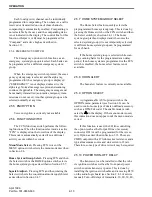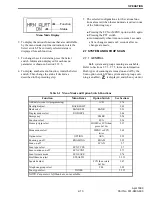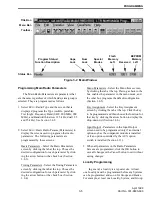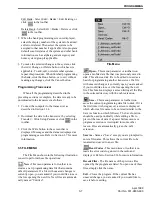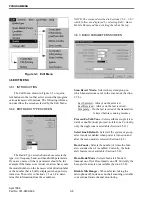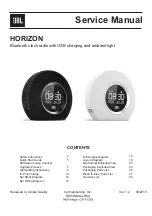
OPERATION
2-23
April 1999
Part No. 001-9800-600
NOTE: Since this feature does not increase system
capacity, adding too many users may result in unsatis-
factory operation due to frequent busy conditions.
Operation With Home Channel Aliasing
If a system programmed with a non-existent
home repeater is selected, the next lower active home
repeater is monitored for incoming calls and go-to
repeater information. For example, if home repeater 6
is programmed on the selected system and the active
repeaters are 1, 10, and 20, repeater 1 is monitored. In
addition, all other mobiles on that locality with a
selected system programmed for home repeaters 1-9
monitor that repeater.
If a group call is then placed, the home channel of
the call is the home channel programmed for the
selected system, not the repeater being monitored. The
call is detected like any other group call (it is received
if a system/group programmed for that home repeater/
group ID is selected or scanned).
Repeater Number Programming With Aliasing
Since the next lower numbered repeater is moni-
tored when a system with a non-existent home repeater
is selected, a numbering scheme should be used that
equalizes, as much as possible, the gaps between the
active repeaters. This equalizes the loading on the
active channels.
When repeater 1 is reached, wrap-around to
repeater 20 occurs. Therefore, the status repeater is
always assigned as Repeater 20 and Repeater 1 as an
active repeater. This prevents the status repeater from
being used as a home repeater which is not desirable
because it then has no backup repeater (see Section
4.6). Examples of repeater numbering schemes are as
follows:
No. of Repeaters
Numbering
1
20
2
1, 20
3
1, 10, 20
4
1, 7, 14, 20
5
1, 5, 10, 15, 20
10
1, 3, 5, 7, 9, 11, 13, 15, 17, 20
2.10 LTR FEATURES
2.10.1 GENERAL LTR FEATURES
LTR operation is described in Section 2.4.8. The
two types of calls that can be placed with LTR opera-
tion are Group and Telephone. Standard Group calls
and other common LTR and LTR-Net features are
described in Section 2.8. LTR telephone calls and
other unique LTR features are described in the infor-
mation which follows.
2.10.2 LTR TELEPHONE CALLS
General
LTR localities which are set up for LTR telephone
calls have a block of ID codes reserved for RIC
(repeater interconnect) calls. For the transceiver to
place and receive telephone calls on those localities,
an LTR telephone group must be programed with an
ID code from this block. Then when this ID code is
decoded (received) or a telephone group is selected to
make a call, the transceiver enters the telephone oper-
ating mode.
To place an LTR telephone call, a telephone
group must be selected; to receive an LTR telephone
call, the telephone ID must be selected or scanned or
have a higher priority. An optional DTMF microphone
is required to dial the telephone number.
Since this transceiver operates half duplex, the
PTT switch must be pressed to talk and released to
listen the same time as with a dispatch call. Therefore,
the mobile user cannot hear the landside caller while
transmitting or speak to the landside caller while
receiving.
Placing an LTR Telephone Call
1. Turn transceiver power on and set the volume as
described in Sections 2.4.1 and 2.4.2.
2. Select the system and group programmed for tele-
phone calls. If equipped with a Telephone option
switch, it can be used to quickly select a telephone
group (see Section 2.8.5). The telephone symbol
is displayed when a group programmed for tele-
phone calls is selected.
Содержание 984X SERIES
Страница 2: ......
Страница 84: ...LTR NET OVERVIEW 4 10 April 1999 Part No 001 9800 600 7KLV SDJH LQWHQWLRQDOO OHIW EODQN...
Страница 85: ......
Страница 86: ...Part No 001 9800 600 4 99hph First Issue Printed in U S A...


